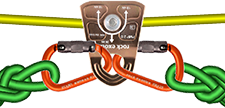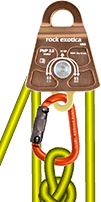
This also applies to cable, chain, and webbing.
Gear that is anchored includes anchors, rocks, trees, tripods, trucks, etc.
A "bight" is a simple loop in a rope that does not cross itself.
A "bend" is a knot that joins two ropes together. Bends can only be attached to the end of a rope.
A "hitch" is a type of knot that must be tied around another object.
"Descending devices" (e.g., ATCs, Brake Bar Racks, Figure 8s, Rescue 8s, etc) create friction as their primary purpose. The friction in descending devices is always considered when calculating forces.
The "Safety Factor" is the ratio between the gear's breaking strength and the maximum load applied to the gear (e.g., 5:1).
vRigger includes more than 30 different pulleys. Pulleys are added to the workspace, and selected, moved, rotated, and sized, like other gear.
Many pulleys permit one carabiner to be attached to the rigging hole.

Some pulleys have larger rigging holes and can connect to multiple carabiners. (You can also use a Rigging Plate to connect a pulley to multiple carabiners.)

Several pulleys have a becket where a carabiner can be connected. Pulleys with beckets usually allow multiple ropes (i.e., they have multiple sheaves). To route a rope through a pulley with multiple sheaves, start at the becket and alternate between dropping the rope on the two pulleys.

The pulley named "Pulley (Exotica Omni 1.5", edge-view)" is unique, because it shows the edge of the pulley.

A pulley's friction depends on its design. Most ball-bearing pulleys have very low friction (e.g., 5% to 10%). A pulley with a bronze bushing will have much higher friction (e.g., 25% to 30%). It is interesting to note that a typical 3:1 system with 5% friction on each pulley is actually a 2.8:1 system (the "puller" will be holding 35% of the total load rather than the expected 33.3%), whereas the same system with 30% friction on each pulley is actually a 2.2:1 system (the puller will be holding 46% of the total load).